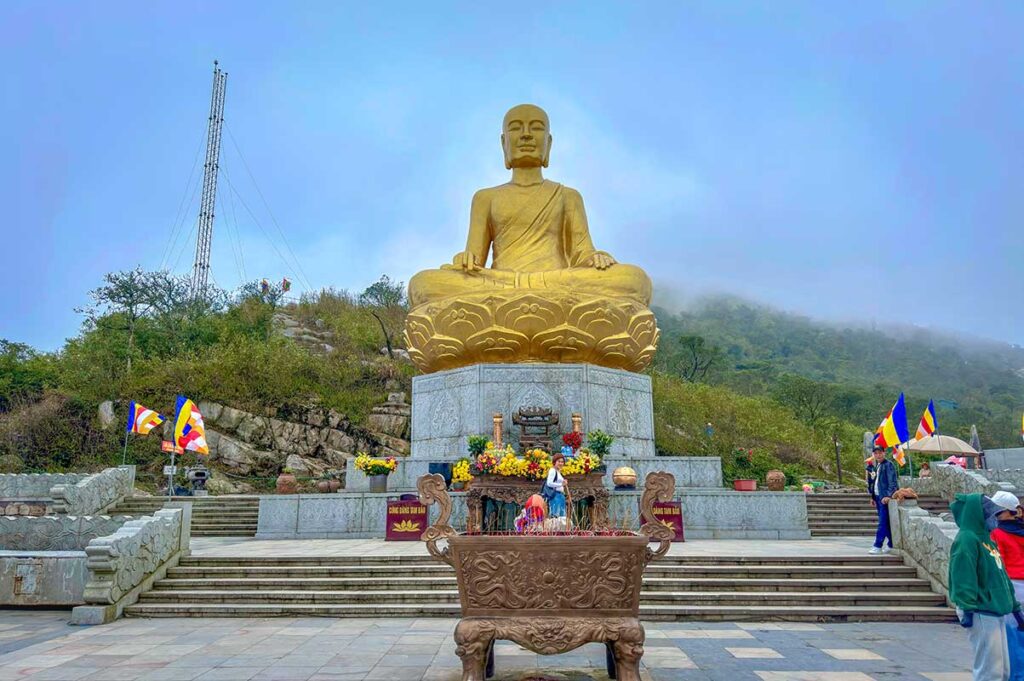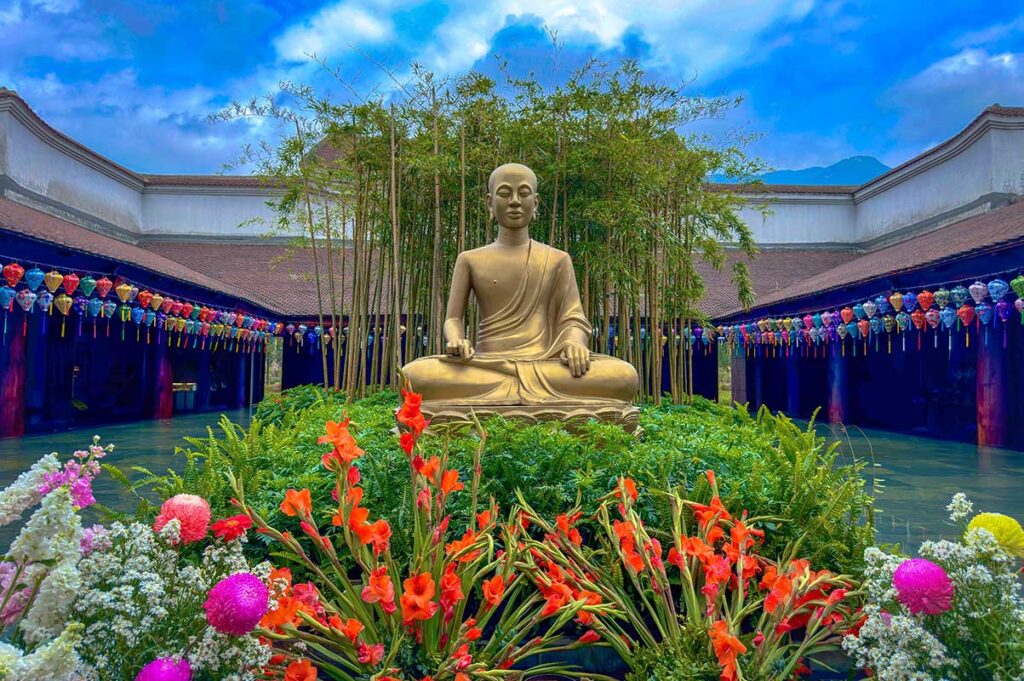Who was Tran Nhan Tong?
Tran Nhan Tong (1258–1308) was the third emperor of the Trần Dynasty, one of Vietnam’s most powerful ruling families. He came to the throne in 1278, at just 20 years old, and ruled for 14 years before abdicating in favor of his son. As emperor, he is remembered for his leadership during two major Mongol invasions, where Đại Việt successfully resisted the mighty Yuan dynasty, ensuring the kingdom’s independence and stability.

What makes Tran Nhan Tong stand out, however, is not only his role as a warrior-king but also his decision to renounce power and wealth to pursue a spiritual path. After stepping down, he retreated to Yên Tử Mountain, became a Buddhist monk, and founded the Trúc Lâm Zen school — the first distinctively Vietnamese school of Zen Buddhism. Because of this dual legacy, he is honored both as a national hero in Vietnam’s history and as a revered religious figure often referred to as the “Royal Buddha.”
Vietnam in the time of Tran Nhan Tong
In the 13th century, Vietnam was known as Đại Việt and was ruled by the Trần Dynasty, a powerful family that controlled the country for nearly two centuries. It was a time of both prosperity and constant threat from the north, as the Mongol-led Yuan dynasty under Kublai Khan expanded across Asia. Đại Việt faced three major invasions from the Yuan, making military readiness and strong leadership essential for survival.
Culturally, Đại Việt was a mix of influences. Buddhism played a central role in court and daily life, with temples and monks holding great influence over the people. At the same time, Confucian values were used to guide governance and education, while local folk traditions shaped festivals, rituals, and village life. This blend of religion, philosophy, and local customs created the environment in which Tran Nhan Tong grew up — one where kings were expected not only to defend the country but also to act as moral and spiritual leaders.
Key events in Tran Nhan Tong’s life
Early Life
Tran Nhan Tong was born in 1258 in the capital Thăng Long (present-day Hanoi) as the eldest son of Emperor Tran Thanh Tong. His given name was Tran Khâm, and from a young age he was recognized for his intelligence and calm nature. Educated by some of the most respected scholars and generals of the time, he was groomed to rule but also showed an early interest in Buddhism. At 16 he was named Crown Prince, despite attempts to pass the title to his younger brother, reflecting both his sense of humility and his growing attraction to a spiritual life.
Reign as Emperor (1278–1293)
He took the throne in 1278 at just 20 years old. Tran Nhan Tong is often described as a capable yet modest ruler who valued the advice of senior family members and ministers. His reign focused on strengthening the kingdom’s defenses, maintaining unity within the royal court, and balancing diplomacy with preparation for war. This balance proved essential as Đại Việt soon faced repeated invasions from the Mongol-led Yuan dynasty.
The Mongol Invasions
One of the defining moments of his rule came during the Mongol invasions. With armies far larger than Đại Việt’s population, the Yuan dynasty posed a serious threat. Tran Nhan Tong, together with his father and generals like Tran Hung Dao, organized resistance that became legendary in Vietnamese history. The Diên Hồng assembly — a gathering of elders from across the country — famously declared their determination to resist at all costs, symbolizing national unity. After years of difficult campaigns, Đại Việt emerged victorious, with decisive battles such as Bạch Đằng River in 1288 securing independence. These victories elevated Tran Nhan Tong’s reputation as both a wise strategist and a unifying leader.
Abdication and Transition
In 1293, Tran Nhan Tong abdicated in favor of his son Tran Anh Tong, becoming Thái thượng hoàng, or Retired Emperor. This was a common practice in the Trần dynasty, allowing younger rulers to take charge while the elder offered guidance. Even after stepping down, he remained active in advising his son and ensuring stability in the kingdom, particularly after the turmoil of war.
Turn to Buddhism
By the end of the 1290s, he withdrew from political life altogether and turned fully to religion. Retreating to Yên Tử Mountain, he formally became a monk in 1299. There he founded the Trúc Lâm Zen school, a distinctly Vietnamese branch of Zen Buddhism that emphasized simplicity, harmony with nature, and living the Dharma in daily life. His poems and teachings — such as “Eating when hungry, sleeping when tired” — reflected an accessible philosophy that combined meditation with ordinary living. This made Buddhism more approachable for the Vietnamese people and cemented his reputation as the “Royal Buddha.”
Final Years and Death
In his later years, Tran Nhan Tong lived in hermitages such as Ngọa Vân, where he meditated, wrote, and taught disciples. Even in retreat, he continued to correspond with his son, offering guidance on ruling wisely and avoiding corruption. He passed away in 1308 at the age of 51, leaving behind both a strong dynasty and a spiritual legacy. His remains were buried at Đức Lăng, and he has since been venerated not just as an emperor but also as a religious leader who embodied the ideal of a king who could transcend worldly power.
Tran Nhan Tong in Vietnam today
Yên Tu Mountain & Trúc Lâm Zen School

The most important place connected to Tran Nhan Tong is Yên Tử Mountain in Quảng Ninh Province. This is where he became a monk, meditated, and founded the Trúc Lâm Zen school. Today, Yên Tử is a major Buddhist pilgrimage site with a network of pagodas, temples, and shrines scattered across the mountain slopes.
For travelers, it’s a mix of cultural heritage and nature: you can hike the traditional stone path up the mountain or take a cable car for easier access. The summit offers not only historical sites but also panoramic views of the surrounding forests. If you’re interested in Buddhism, Vietnamese history, or just a scenic day trip, Yên Tử is one of the best places to connect with Tran Nhan Tong’s legacy.
Ngoa Vân Pagoda & Hermitage
Ngọa Vân, located in modern-day Quảng Ninh, is the site where Tran Nhan Tong spent his final years. It was here that he meditated in seclusion and eventually passed away in 1308. The site is less visited than Yên Tử, but it holds deep spiritual meaning for many Vietnamese Buddhists.
The pagoda complex is set against a quiet mountain backdrop, making it a peaceful destination for those who want to experience a more contemplative side of Vietnamese Buddhism. Getting there is not as straightforward as reaching Yên Tử, but that remoteness is part of its appeal if you’re looking for something more authentic and away from big tourist crowds.
Monuments, Festivals & Modern remembrance
Tran Nhan Tong’s influence is still visible throughout Vietnam. Many cities have streets, schools, and statues named after him, a sign of how deeply he is respected both as a national hero and religious figure. In Quảng Ninh, you’ll also find monuments dedicated to his life and the Trúc Lâm Zen tradition. Every year, Buddhist followers organize commemorations of his death anniversary, particularly at Yên Tử, where ceremonies combine traditional rituals with cultural performances. These events attract both pilgrims and curious travelers, though the atmosphere is more spiritual than touristy.
For everyday visitors to Vietnam, you might not encounter Tran Nhan Tong in obvious tourist attractions like Hanoi’s Old Quarter or Halong Bay, but if you explore further — especially in the northeast — his legacy is woven into the culture, religion, and history that still shape Vietnam today.
Other famous Emperors of Vietnam
Tran Nhan Tong stands among Vietnam’s most respected historical figures, but he is part of a long line of rulers and leaders who left their mark on the country. Knowing a few of the others gives more perspective on how different dynasties shaped Vietnam’s history.
- Lý Thái Tổ (reigned 1009–1028) – Founder of the Lý Dynasty and the one who moved the capital to Thăng Long (present-day Hanoi), laying the foundation for a stable and prosperous era.
- Trần Hưng Đạo (1228–1300) – Not an emperor but a prince and military commander, he is one of Vietnam’s greatest national heroes, remembered for leading resistance against the Mongol invasions alongside Tran Nhan Tong.
- Lê Lợi (reigned 1428–1433) – Leader of the Lam Sơn uprising against the Ming occupation, he became the first emperor of the Lê Dynasty and is celebrated for restoring Vietnamese independence.
- Gia Long (reigned 1802–1820) – Founder of the Nguyễn Dynasty, he unified Vietnam after centuries of division and established Huế as the imperial capital.
- Minh Mạng (reigned 1820–1841) – Second emperor of the Nguyễn Dynasty, known for administrative reforms, strengthening Confucian values, and commissioning many of the imperial tombs and structures still standing in Huế today.



